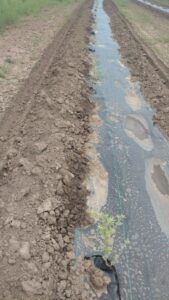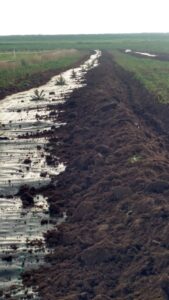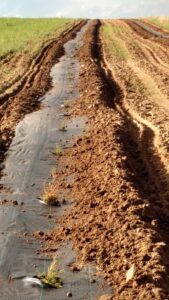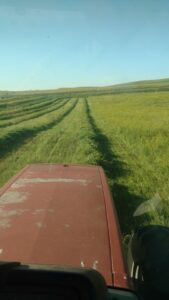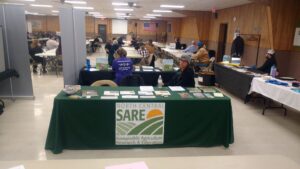Final report for FNC18-1123
Project Information
My brother Drew and I grew up on a farm and ranch in southwest North Dakota. Upon graduation from high school, we knew that we wanted to be involved with the agricultural industry. Over time, it became clear that we wanted to be actively involved with production agriculture.
For over ten years, Drew worked in the oil industry where he became a proficient mechanical engineer. By working in an outside industry, he found and created opportunities to become involved with ranching on a full-time basis. He now manages a cow-calf operation and 970, 110, 240 and 160 acres of native, improved pasture, winter forage/hayland, and CRP, respectively. Unfortunately, much of his land was abused. Farming practices and severe over grazing left the soil to erode by wind and water. He has worked with NRCS USFWS, ND State Water Commission and others to transition from a 3-cell pasture rotation relying on dugouts for water to a 20-cell rotation with miles of pipeline, multiple wells (solar and conventional), dams for wildlife, cover crops for bees and soil health and over a mile of trees. He continues to work closely with these groups to address resource concerns and make long-term improvements in an effort to revitalize the land and improve wildlife habitat.
I have spent the last few years working off the farm to advance my knowledge of production agriculture and am in the process of transitioning back to the farm and ranch. Every position of employment has aided my overall understanding of natural resource management. I have also earned an M.S. and am working towards a Ph.D. in Range Sciences which helps me to not only design useful experiments, but also interpret and integrate research from the areas of cropping systems, farm economic management, animal systems, and natural resource management. Currently, I own a small herd of cattle and 160 acres of cropland. I am working to build soil health by managing the land as a pollinator cover crop that will be converted to a perennial system.
This project was designed to address the resource concerns of land that had been historically farmed with no inputs and depleted to a point of no longer being productive. To rejuvenate the land and demonstrate how sustainable agriculture can be adapted to fit each operation, project coordinators used bale grazing. This management strategy allowed us to demonstrate a practice that was ecologically sound, profitable and socially responsible.
To measure benefits and impacts from the project, we focused our efforts on soil health. Samples were collected before, during and after project completion to monitor soil nutrients, biological activity and physical structure. Though soil health is the main focus, we also observed other areas of impact because the land works as a system. During July through October of each growing season, bee counts were collected every 2 weeks. This enabled us to monitor the percent bloom of plants within the pollinator planting and also track the number of bees that were appearing throughout the growing season. Body condition of livestock was monitored with each rotation through the bale grazing site. This assessment helped us to make sure that nutritional requirements were being met and maintained. During the spring, calving ease was monitored to help us understand if physical activity during the gestation period was effecting the animals.
The measurement of various parameters helped us gauge our efforts towards developing a more sustainable system. Though this was an important step, the demonstration component of this project helped create momentum within the agricultural industry. Documenting the project through social media, developing a driving/walking tour of the study area and participating in local events helped share information. Because it was presented in various formats, people from all walks of life were able to observe the conservation practice in whichever way suited them most. The demonstration aspect helped producers consider how management practices can be adopted to help them achieve their own ecological, economical and social goals.
1. Improve soil health and fertility, eliminate use of commercial fertilizer
2. Increase nutrient cycling and reduce nutrient runoff
3. Improve herbage production and forage quality
4. Improve herd health by extending grazing season
5. Reduce feed and labor costs
6. Monitor effects on pollinator habitat
7. Share findings through self-guided tours, field days, extension publications and testimonials to improve understanding of sustainable agriculture
Cooperators
- (Educator and Researcher)
- (Educator)
Research
This project was designed to address resource concerns of land that was historically farmed with no inputs and depleted to a point of no longer being productive. To rejuvenate the land and demonstrate how sustainable agriculture can be adapted to fit each operation, project coordinators used bale grazing.
Prior to implementing the project, soil samples were collected to provide us with an analysis of conditions. The next step was to meet with a planning committee to help organize and guide our efforts.
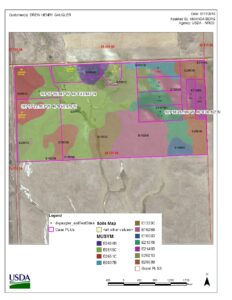
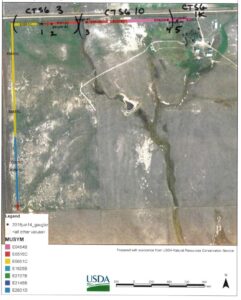
Gaugler-Tree-Planting-Write-Up
During the spring of 2018, a cover crop mixture that included 15+ species was planted on the bale grazing site which was approximately 84 acres. The mix included the following: 5% buckwheat, 10% flax, 7% radish, 10% hairy vetch, 5% phacilia, 7% 410 pea, cowpea, 7% safflower, 15% millet, 5% red clover, 9% barley, 5% sunflower, 10% rape, and 5% sweet clover. The diversity of the cover crop planting helped to create a habitat for pollinators and a symbiotic relationship among plant species that promoted soil health. The majority of the cover crop mix performed well, but we didn't notice a large population of cowpeas. Because of our satisfaction with this cover crop mix, we will likely consider a similar blend in the future. The cover crops were grazed in the fall, then the site was prepared for bale grazing. While grazing cover crops, the cattle showed preference to rape, millet, and hairy vetch but they did not consume safflower.
Mid-summer 2018, hay was harvested on other hayland acres. Installation of permanent fence around the trees and field prep was conducted during the summer and fall.
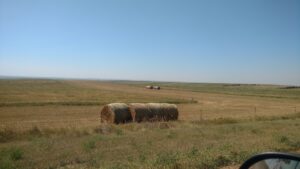
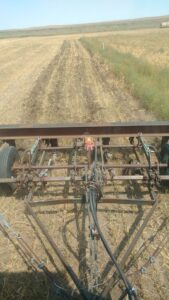
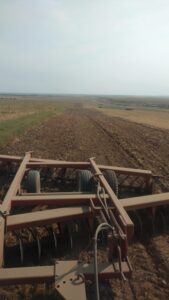
Permanent fence around the trees was designed to protect the the plants from livestock and wildlife and will allow for flexibility with grazing cells.
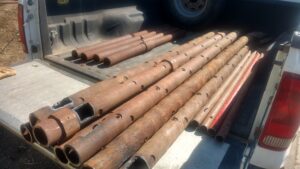
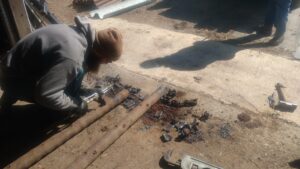
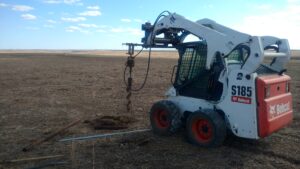
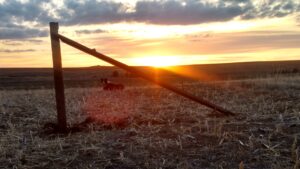
In late fall 2018, hay was hauled to the grazing area and bales were distributed across the landscape with special emphasis on places where additional organic matter was needed. Temporary fencing was installed and approximately 200 cattle began to move through the system in late fall or early winter. As shown in the pictures below, net wrap was not removed from the bales prior to grazing. Cattle worked their way through the net wrap to eat the hay and the material bundled itself up and was kicked to the side. Net wrap was picked up and removed from the landscape to keep from causing problems. Each time we went out to check on the cows, or assess one of our many parameters, we simply filled up the back of the pickup with net wrap and removed it from the site.
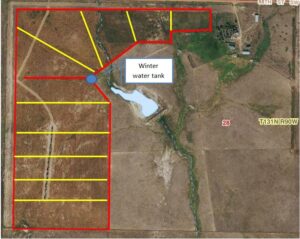
Various parameters were measured throughout the duration of the study to assess the impact of bale grazing. These parameters included but were not limited to: analysis of soil, bee counts and livestock performance.
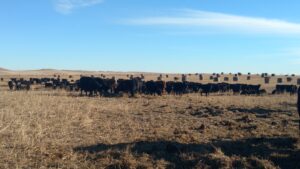
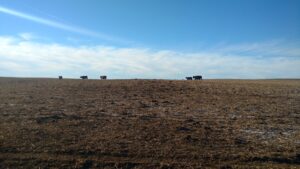
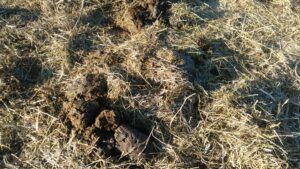
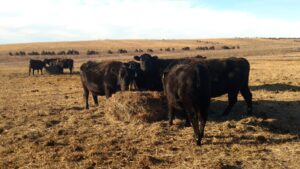
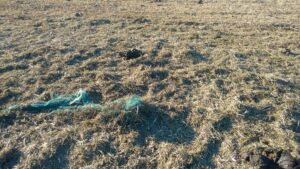
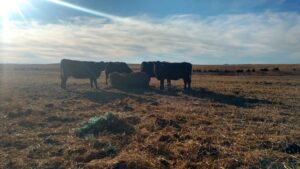
Robin Salverson with South Dakota State University Extension came to the bale grazing site in mid-December 2018 to observe the bale grazing system. Robin took pictures and made notes that will be used in a presentation that she will be sharing with producers, landowners, local stakeholders and more.
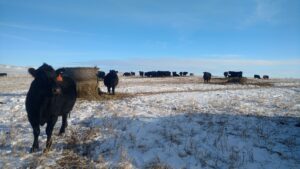
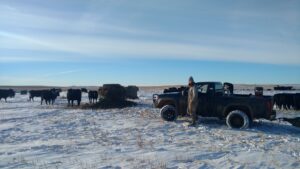
The perennial planting occurred spring of 2019, along with a nurse crop of flax. The planting occurred on 84 acres and included Anik Falcata alfalfa, intermediate wheatgrass, western wheatgrass, red clover, and Dacotah switchgrass. The cost of the perennial planting was significantly reduced because the quoted seed price was significantly higher the previous year when the proposed budget was being created.

Trees were planted spring of 2019 by the Adams County Soil Conservation District and included Ponderosa Pine, Juniper, Black Hills Spruce, and Armor Maple. The district over planted beyond the estimated footage, so additional expenses were incurred. The quality of the tree planting and weed barrier application was quite poor. Drew Gaugler spent many hours removing excess soil from fabric, lifting bottom branches of trees from soil, and burying roots from other trees that were exposed. Dissatisfaction was expressed to the board through direct correspondence and by participation in a board meeting. Currently, the success and survival rate of trees appear hopeful but a resolution to the quality of work has not been met.
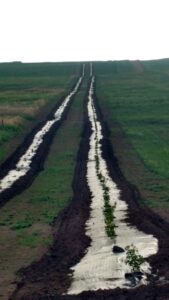
Perennial planting was hayed mid-summer of 2019.
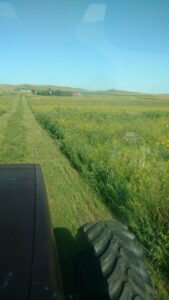
In late fall 2019, harvested hay from perennial planting was distributed across the landscape with special emphasis on places where additional organic matter was needed. Temporary fencing was installed and 300 cow/calf pairs plus 40 bred heifers began to move through the system in late fall or early winter. As shown in the pictures below, net wrap was not removed from the bales prior to grazing. Cattle worked their way through the net wrap to eat the hay and the material bundled itself up and was kicked to the side. Net wrap was picked up and removed from the landscape to keep from causing problems. Each time we went out to check on the cows, or assess one of our many parameters, we simply filled up the back of the pickup with net wrap and removed it from the site.
Various parameters were measured throughout the duration of the study to assess the impact of bale grazing. These parameters included but were not limited to: analysis of soil, bee counts, and livestock performance.
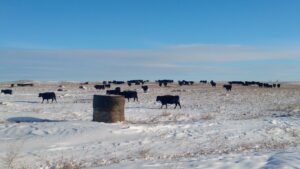
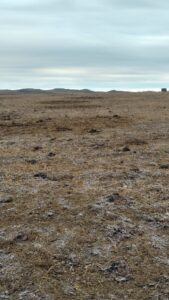
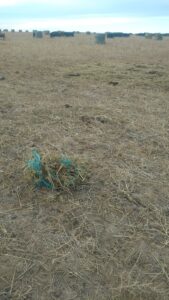
Fall of 2019, soil samples were collected for nutrient analysis.
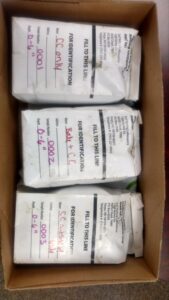
Preliminary soils data was used to assess current conditions, monitor progress, and estimate needed soil amendments.
Body condition of livestock was monitored during the late fall and early winter of 2018 and 2019 while bale grazing. It was estimated that overall body condition was not significantly different when compared to how animals were previously wintered. We suspect that this is because the nutrient demands of our animals were being met and maintained. Hay samples were probed and nutrient analysis was performed to help ensure that livestock needs were being addressed.
Calving ease was monitored spring of 2019 and it was estimated that overall calving ease was not significantly different when compared to how animals were previously wintered. We suspect that this is because our animals have had a moderate level of physical activity throughout gestation.
2019 Soil Report (1) 2019 Soil Report
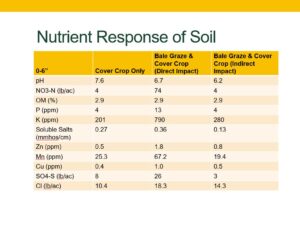
The soil samples collected during the fall of 2019 indicate that bale grazing had a direct effect on various parameters of soil nutrients. The direct impact samples were collected directly under a bale; whereas, the indirect impact samples were collected outside of the area where a bale was grazed. It is important to note that levels of organic matter did not change from one treatment to the next, nor over time. This is likely because the project area had been poorly managed for many years prior to acquisition and it will take time to reactivate the microorganisms in the soil and build organic matter.
Educational & Outreach Activities
Participation Summary:
Various activities were conducted to share information about the project, "Bale Grazing to Build Soil Health." During the first year of the project, one of the things that we prepared was a self-guided, mailbox tour which was available throughout the late fall and early winter grazing months of 2018 and 2019. Flyers were prepared and posted on bulletin boards in local businesses. We also reached out to local NRCS and SCD offices to share the information with producers. The flyer detailed the project, provided directions to the demonstration site and listed contact information for project coordinators. Once producers arrived at the project location, a handout was provided that detailed information about bale grazing, benefits of bale grazing, project design, timeline and reporting. Producers were able to guide themselves through a tour of the bale grazing site or they could contact us for a more thorough tour. 30-40 producers have participated in the self-guided tour and several more have simply kept an eye on the project from the highway. In the future, we plan to invite the Grant County SCD board to tour the site. We feel that this would be appropriate because they not only wrote us a letter of support for our Farmer Rancher SARE Grant Application, but also have a special interest in bale grazing and provide grant opportunities to local producers.
Self-Guided Tour, Mailbox Handout
Erin has had the opportunity to write an article about, "Winter Feeding Strategies for Beef Cattle," in which she highlighted the practice of bale grazing. This article was circulated in a newsletter that went out to 500 producers. Robin Salverson with SDSU Extension has inquired about co-authoring articles and extension publications that detail similar types of practices.
Information about the SARE program and specific details about the bale grazing project was shared at the Grant County Ag Day in New Leipzig, North Dakota. The Ag Day provided us with an opportunity to promote the mailbox tour and talk with producers about the SARE program and how it could be beneficial to them. Coordination with Karl Hoppe, a North Dakota State SARE Co-coordinator helped to make this possible.
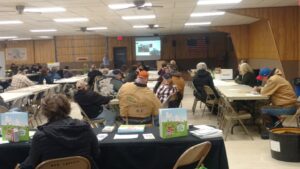
Throughout the project, videos, photographs and other information was collected. Some information about bale grazing has been shared through Facebook.
During January of 2020, Drew and Erin had the opportunity to use the collected information to share about our project at the Northern Plains Sustainable Agriculture Society's Food and Farming Conference as part of the NCR-SARE Farmers Forum. We presented our project, Bale Grazing to Build Soil Health. The presentation was videotaped and will be posted on the NCR-SARE Youtube channel. Additionally, Erin participated in the SARE Grant Writing Session with Beth Nelson and provided input about her experience.
Learning Outcomes
Bale Grazing to Build Soil Health has taught us that bale grazing is an effective strategy for wintering cattle. If designed correctly, it has the potential to save time, ease labor, reduce winter feeding costs, and positively impact soil health. The success of our project has encouraged us to expand our areas of impact and renovate more hayland acres by bale grazing. Where there are several advantages to bale grazing, there are some mitigation strategies that should be considered for adverse weather (e.g. hoarfrost). If asked for more information or recommendation, we would encourage other farmers and ranchers to visit and consider how bale grazing can help meet the needs and objectives of their own operation. We would reiterate that bale grazing, like any other strategy or practice, can be implemented in many unique ways which is important because each operation is different.
The below question, "is hard to report a number for. Part of the intent of outreach was to target producers who do not attend traditional outreach efforts. Producers could see what was being done from the highway and others did the self-guided tour but replaced the handout in the mailbox so quantifying a number was an estimate.
Project Outcomes
Many people travel up and down North Dakota Highway 49 and numerous active and retired producers have commented on the bale grazing study. Folks in the local area have asked us several questions about what we are doing with the bales and they wonder how it works. Drew and I have noticed that a handful of those same people have begun to implement bale grazing on their own operation. Each time they see us, they ask us more questions. We tell them that much of why we do what we do is driven by the resource and our personal goals, and we encourage others to consider their priorities. "Bale Grazing to Build Soil Health" has created a unique momentum for others to adapt their own strategies for success.
Our outreach efforts, like mailbox tours, encourage people to learn about bale grazing without having to participate in a formal event. It is hard to know the numbers of impact because of our strategy to reach people in a unique way. The location of our study allows many folks to observe the project without us ever knowing that they are paying attention to our efforts. So, numbers were projected for participation but they only represent an estimation.
As we have progressed through the project, multi-species grazing has become of interest to us for several reasons and a proposal for a Farmer Rancher Grant has been submitted. A benefit of incorporating sheep is that manure distribution is more evenly spread across the field and soil compaction is limited. As opposed to cattle, sheep are less selective in browsing near manure deposits which results in improved feed efficiency. There is an additional opportunity for improved parasite control. While bale grazing and the incorporation of multi-species has shown benefits, neither management practice has been widely adopted. We are also curious to learn if sheep can be incorporated in a way that doesn't create a large amount of labor (e.g. fence adaptation and more).
We have really enjoyed the process of working with SARE and find that they are practical and open minded. It is nice to know that there is a group out there that understands the realities of farming and ranching. Our interaction with staff has also been pleasant - personable and helpful. We are grateful for the opportunity to continue to learn from our Bale Grazing to Build Soil Health Project.
